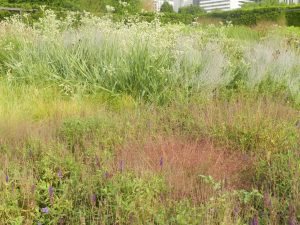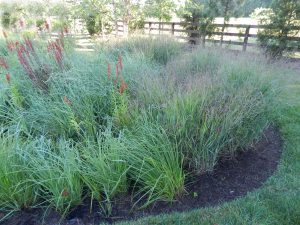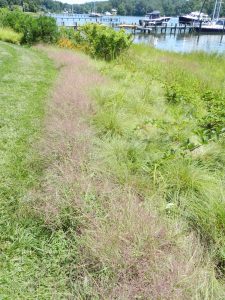Ornamental grasses could and should be part of a perennial garden. They add textural contrast as well as a long presence, both in and out of flower. Most gardeners are acquainted with Miscanthus (Maiden Grass), Pennisetum (Fountain Grass), and Panicum (Switch Grass) but not with Eragrostis.

Eragrostis spectabilis is interspersed as part of the matrix in Salvia ‘Caradonna’ that is past bloom in front of Eryngium yuccifolium and Perovskia at the Millenium Park Lurie Gardens in Chicago that were designed by Piet Oudolf.
Eragrostis spectabilis is a sorely underused ornamental grass. Native to the U.S. and Canada, it can perform as part of a matrix in a meadow or prairie planting but also works well in a perennial garden to as long as it is in full sun. Although very drought tolerant once established, it is quite adaptable to moister sites as long as the soil is well-drained.

Closeup of Eragrostis spectabilis in bloom.
Eragrostis spectabilis is a dense clumper that is rhizomatous. When in bloom in late summer and fall, the pinky-purple, delicate inflorescence creates an airy halo effect above the loosely mounding, bluish-green foliage that is usually about a foot high and wide. The inflorescence will be another foot high but is see-through. As the seeds mature in October, the inflorescence usually detaches from the plant and blows along the ground like a tumbleweed distributing seed as it goes. You can prevent seeding by pruning the inflorescence at that time.
The toughness of this grass is demonstrated by its resiliency in pavement edges and in parking lots. It is both salt and deer tolerant as well as drought tolerant. Happily, it can also be grown near black walnut trees. It would be quite useful in controlling soil erosion or as a tall lawn substitute.

This bed functions as a rain garden on a mild slope. Lobelia cardinalis takes the brunt of the runoff with Eragrostis spectabilis and Sesleria autumnalis on the lower edges.

A river of Eragrostis spectabilis runs across the near bottom of a slope to divide the planted area from the natural area closer to the river.
Amazingly, this grass is also used in rain gardens, usually at the top or on a slope. In 2015, while on a PPA tour of gardens near Annapolis, I visited several gardens on properties abutting the Severn River which drains into the Chesapeake Bay. Construction regulations specified the need for drainage intervention since the area tends to flood periodically. Large beds between the houses and the river were designed with grasses and perennials that could withstand very wet conditions as well as dry conditions. Eragrostis spectabilis was used on all of the sites we saw.

I like interspersing Verbena bonariensis between clumps of Eragrostis because the Verbena blooms earlier and makes that area interesting before the Eragrostis blooms.
I’m not sure why Eragrostis is described as short-lived but I suspect that it is only short-lived where the drainage is not good. I included it in a suburban Cleveland xeriscape that was installed in the spring of 2020. The site had the usual heavy clay soil found in Cuyahoga County so we amended heavily with Turface MVP. The Eragrostis is thriving and looks spectacular in late summer when both it and the Verbena bonariensis with which it is interplanted are in bloom.
Purple Love Grass (what’s not to love?) has so many attributes that I’m sure you will now start including it in your designs.


1 Comment